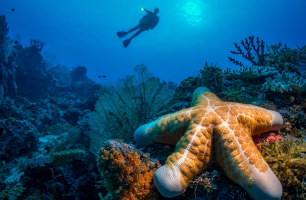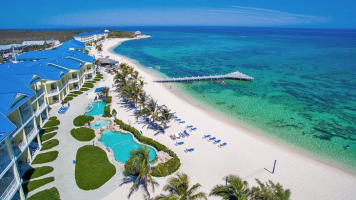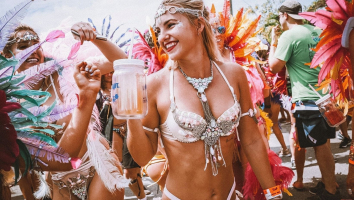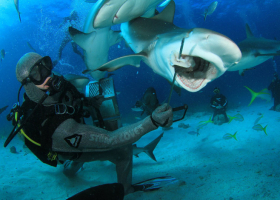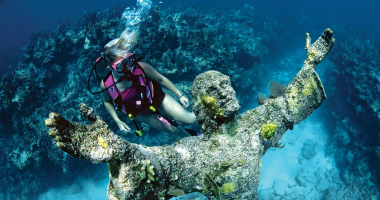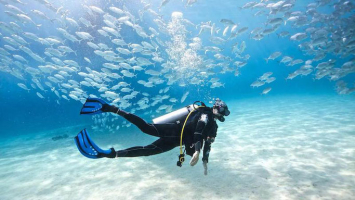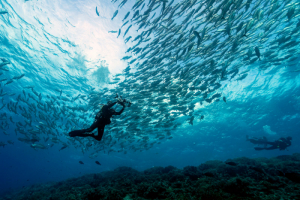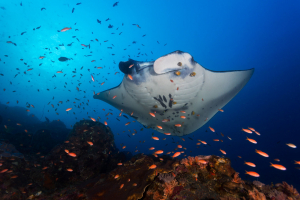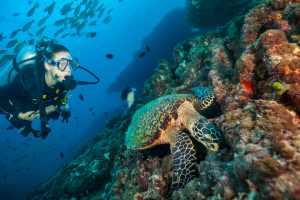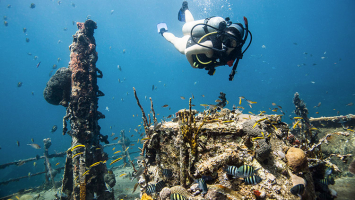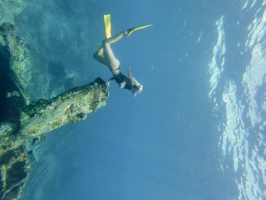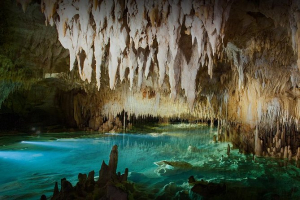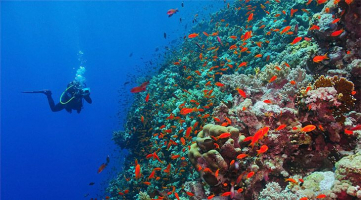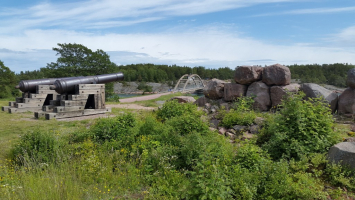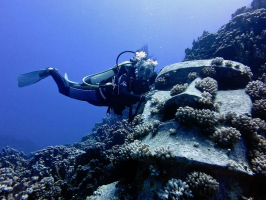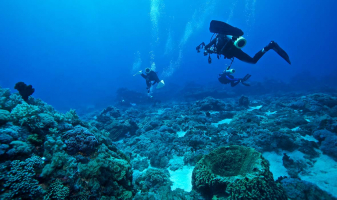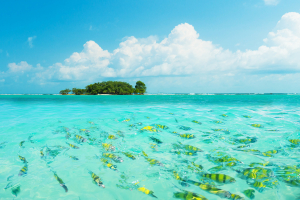Top 11 Dive Sites in The Cayman Islands
There are fantastic diving conditions all over the Cayman Islands, including great visibility, warm water, low currents, and some of the Caribbean's most ... read more...colorful reefs teeming with marine life. Cayman Island also has some of the most spectacular walls dives in the world due to its location directly above the Cayman Islands trench, which drops nearly 6,000 feet just a short distance offshore. In addition to these wonderful natural features, the Cayman Islands has recognized the importance of the scuba diving tourism industry and has gone to great lengths to create and protect dive sites. Here are some of the top dive sites in the Cayman Islands.
-
Divers exploring the Kittiwake will find a lot to love. The vessel sits in shallow water, allowing plenty of bottom time to take in the sights — highlights include the mess hall, the massive propellers and towering smoke stack, two recompression chambers and the head complete with an intact mirror. The iconic wheel house had its panels removed after being damaged by a storm in early 2017. Scuba divers can still pose at the captain’s wheel, although they may feel more like they are driving the world’s largest convertible.
Tropical Storm Nate hit Kittiwake in October of 2017. The wreck was mostly unharmed, but it now sits at an odd angle. Open-water divers are limited to the first three decks, but those with advanced certifications — such as a rescue diver or wreck-diver — can fully explore all five decks. Consider taking a course while scuba diving in Grand Cayman if you don't already have it — Kittiwake is a great place to start.
Kittiwake, on the other hand, is more than a shipwreck; it's also an artificial reef, and the marine life here can be just as much of a draw for divers. Peppermint shrimp, arrowhead crabs, fire worms, and banded coral shrimp are among the macro life found on the wreck. Garden eels have taken up residence in the sands around the ship, attracting southern stingrays and eagle rays. Barracuda, schools of horse-eye jacks, turtles, and grouper are among the fish that frequent the area.
Location: Grand Cayman, Cayman Islands
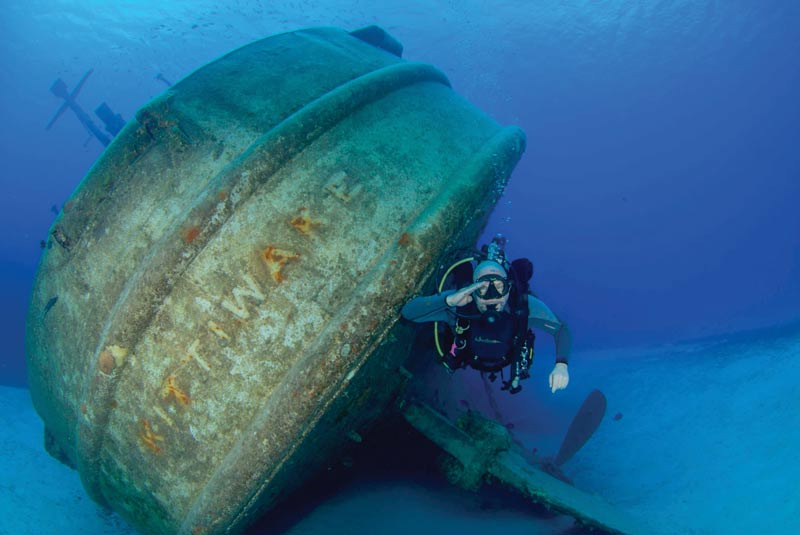
divermag.com 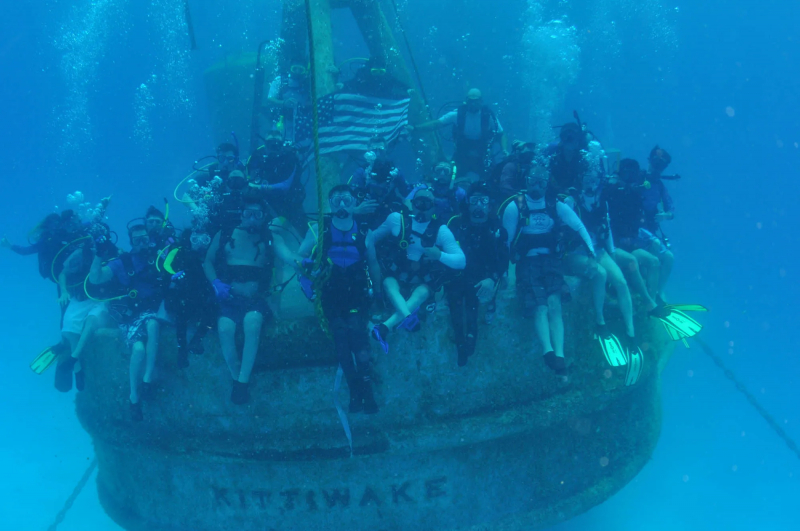
thescubanews.com -
Sunset Reef is a popular shore dive located just 60 meters (200 feet) off the pier of the Sunset House Resort. Divers aren't likely to see a mermaid on a dive very often, but they can at Sunset Reef. The first manmade feature, a 9-foot mermaid in about 50 feet of water, can be found here. The statue, dubbed Amphitrite, Siren of Sunset Reef, is a popular attraction — just don't ask why her nipples are the only shiny part of the bronze sculpture.
You may need to return depending on your air. But if you've got some extra time on your hands, go deeper. As you approach, look for waves of garden eels poking their heads out of the sand and retreating in a cascade. Even novice divers should have enough air left for a little more exploration at that point. Another manmade shape will loom out of the blue as you walk out across the sand — a World War II landing craft. This wreck, which sits in only 60 feet (18 meters) of water and is frequently occupied by angelfish and snappers, makes for a great first wreck experience. You can explore a semi-closed area, but there are no dangers to be found.
Location: Cayman islands
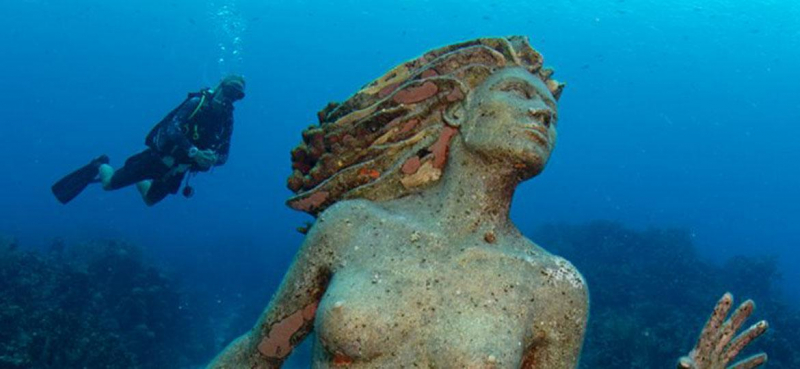
explorecayman.com 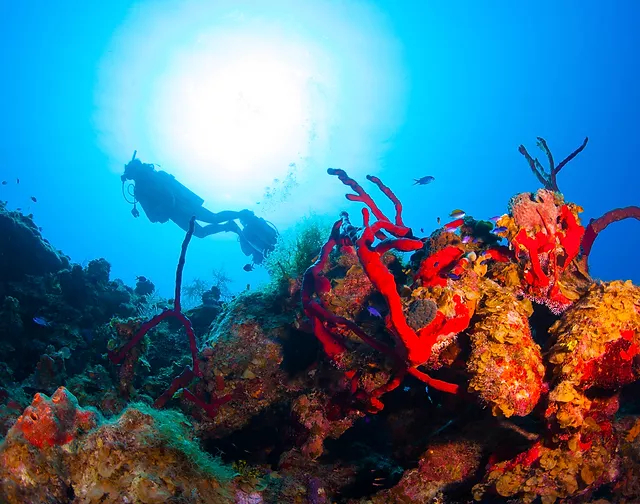
sunsetreefhouse.com -
Bert Brothers Boulders is located on Cayman Brac's north end. It's a dive site that's been famous for years because of its massive coral heads that are amazingly decorated with soft and hard corals. This is one of the best dive sites in the Cayman Islands, with wicked swim-throughs and huge undercuts formed between the gullies and ridges. Bert Brothers Boulders is a stunning dive site on the Cayman Islands.
To begin, there's a 12-meter-deep (40-foot) reef with massive coral heads strewn with both hard and soft corals. Along with tube sponges, stunning elkhorn corals, and sightings of the house green moray eel, the topography here forms exciting swim-throughs and overhangs. Between the shore and the reef wall, densely packed ridges form huge coral heads. The tops of the ridges are adorned with elkhorn corals, while the gullies are home to large gorgonians, tube sponges, and hard corals. Flamingo tongues cling to sea fans in the shallows, while lobsters, eels, and jewfish hide in ridges and gullies. Bert Brothers Boulders is also a great place to see flying gurnards, which can be seen from a distance of about 5.5 meters (18ft).
Location: Cayman Brac, Cayman Islands
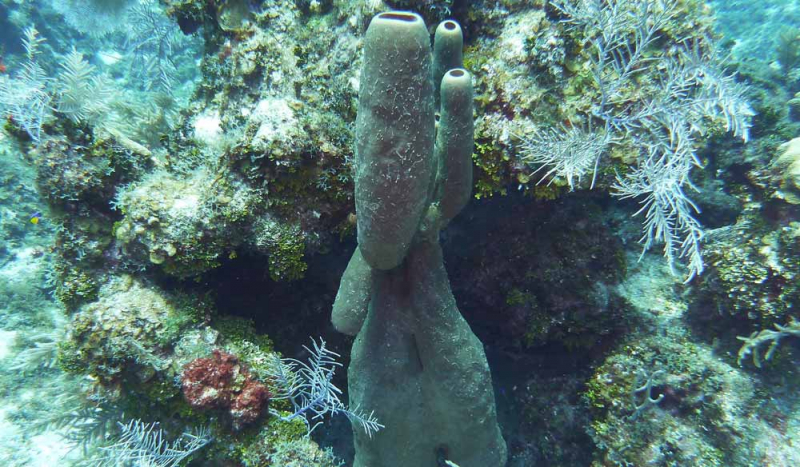
divein.com 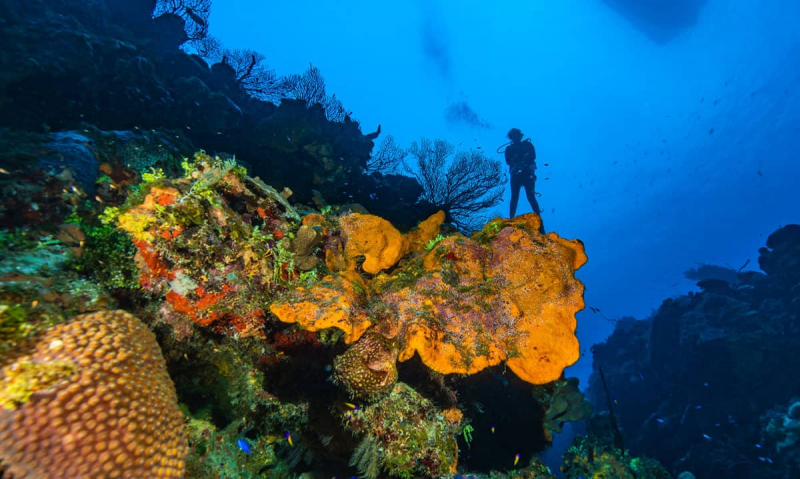
divein.com -
Tarpon Alley, one of the best dive sites in the Cayman Islands, is a scuba diving spot on the Cayman Islands' North Wall. It is located just outside of the North Sound, with depths ranging from 15 to 25 meters (50-80 feet), and it can be a great dive site when the water is clear. The site's varied topography, which includes canyons and drop-offs, makes it a favorite among photographers. You will typically find a few to dozens of tarpon in the area.
The tarpon adults are about 4 to 6 feet in length (although you can see some larger) and weigh up to 300 pounds (for the largest fish). The males are typically smaller than the females. You will also find some nice Deepwater Sea Fans on this scuba diving site along with cactus corals, Spiny Flower Corals, Great Star Corals and more along with various vase sponges and tube sponges. The sharks, particularly hammerheads, are the main reason for diving here. Barracudas, yellowtail snappers, hawksbill turtles, and stingrays that sleep in the sand are among the other highlights in Tarpon Alley.
Location: Cayman Islands
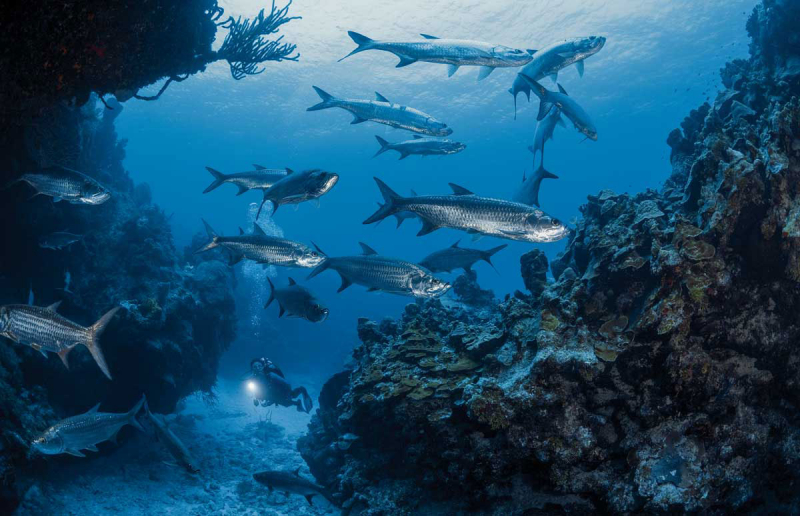
scubadiving.com 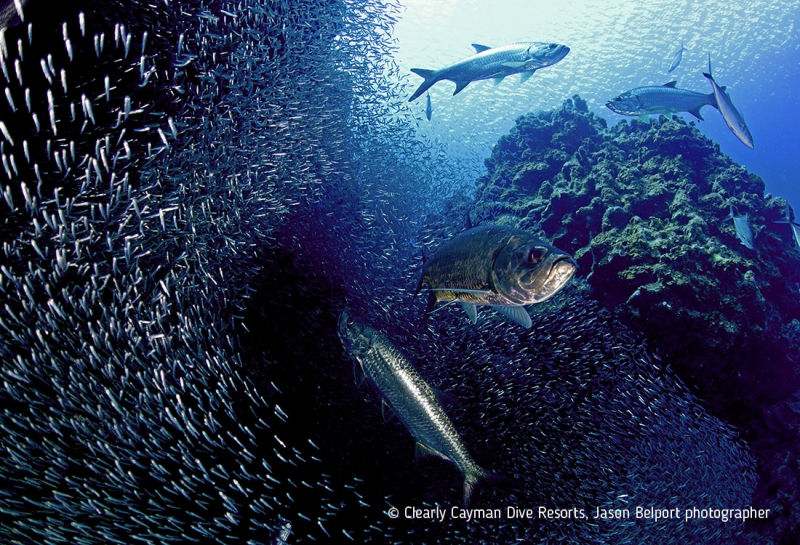
caradonna.com -
Trinity Caves, on Grand Cayman's west side, is one of the most popular dive sites in the Cayman Islands. It is the place to be if you enjoy diving in caves and grottos. The main swim through is 70 feet deep where you can follow the tunnel back and around out onto the main wall. From the sand flats to the reef wall, three long, wide tunnels are accessible to the majority of divers. Cracks in the ceilings let plenty of natural light in, making it easy to search the nooks and crannies for the numerous crustaceans and other marine creatures that call the tunnels home.
Trinity Caves is one Cayman dive site that never disappoints. Crabs and lobsters are among the critters hiding in the crevices. Sharp-eyed divers can find leopard flatworms and the tunnels are also popular hangouts for rays and green moray eels. Out in the open, expect schools of Nassau groupers, turtles, and snappers.
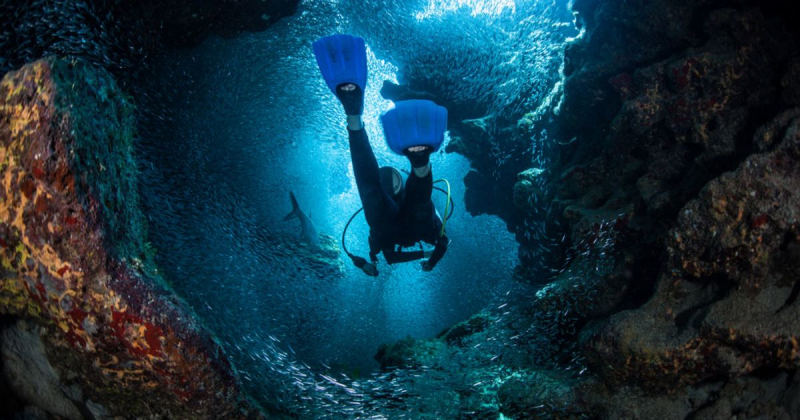
scubadiving.com 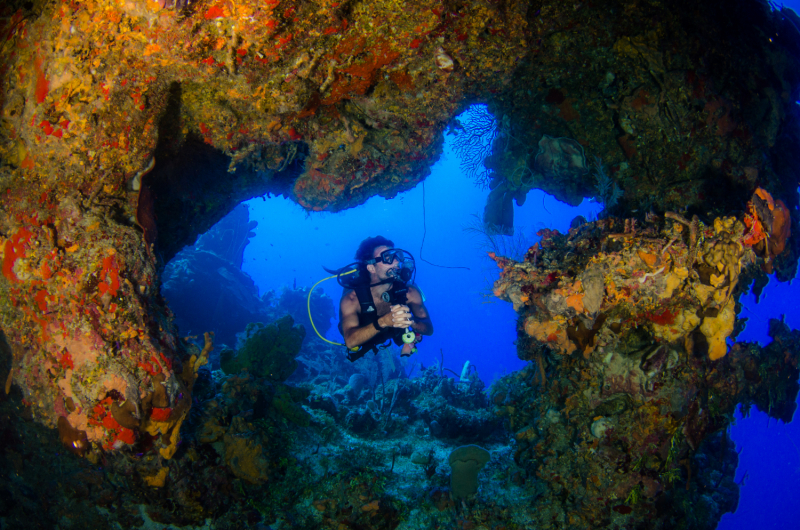
dresseldivers.com -
No diving trip in Grand Cayman would be complete without a dive at the infamous Stingray City. The dive site is in the North Sound of Grand Cayman. Stingray City provides divers with the opportunity to visit a breathtaking habitat bursting with multiple species of gorgeous tropical fish, thanks to more than 20 local stingrays who are as hospitable and friendly as any small-town welcoming committee. Stingrays, stingrays, and more stingrays are what attract divers to this Cayman location. These creatures are naturally docile and will swim around you in the shallow reef area without harming you. These rays aren't afraid to touch you, and as they surround you, they appear to enjoy a gentle stroke or two.
To keep the old tradition of feeding the rays alive, most dive boats bring a small amount of squid to Stingray City. It is one of the most well-known dive sites in the Cayman Islands, thanks to the large number of rays and the calm, protected waters. Aside from the stingrays, there are a few coral heads to explore with a variety of marine life.
Location: North Sound of Grand Cayman, Cayman Islands
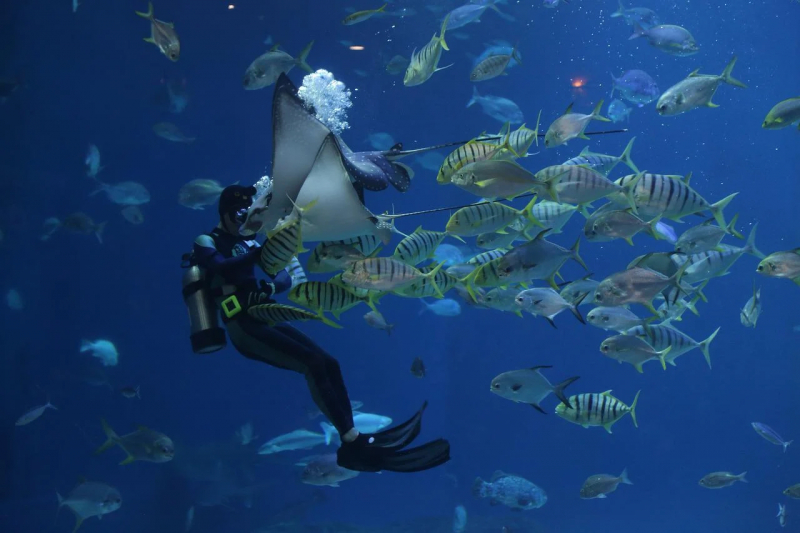
pixabay.com 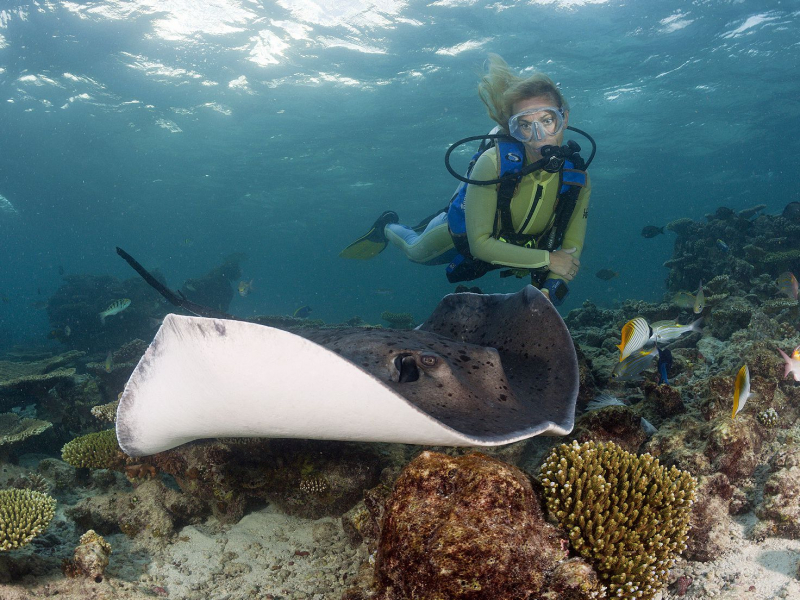
loveabout.com -
The Kittiwake comes to mind when thinking of wrecks on Grand Cayman, but the wreck of the Oro Verde is also worth a look. The Oro Verde, which translates to "green gold," was originally a transport ship for the United States Army. The Oro Verde was once a complete ship, but rough seas and tumultuous weather have scattered the wreckage. Because the wreckage is dispersed, it is not a penetration dive, so even inexperienced divers can enjoy the site.
Crabs, eels, and lobster hide under the many overhangs in Oro Verde. Parrotfish and schooling chubs, horse-eye jacks, snapper, goatfish, blue tangs and the occasional barracuda all hang around, looking for a meal.The soft coral attracts rays and turtles, who frequent the area. Water temperatures in Grand Cayman range from 76 to 82F (24 to 28 C), with September being the hottest. Most people will be fine in a 3mm wetsuit, especially on shallow dives like the Oro Verde. The hurricane season runs from June 1 to November 30, with the most active months being October and November. The most popular time to visit is February to April.
Location: on the reef surrounding Grand Cayman, right off Seven Mile Beach, Cayman Islands
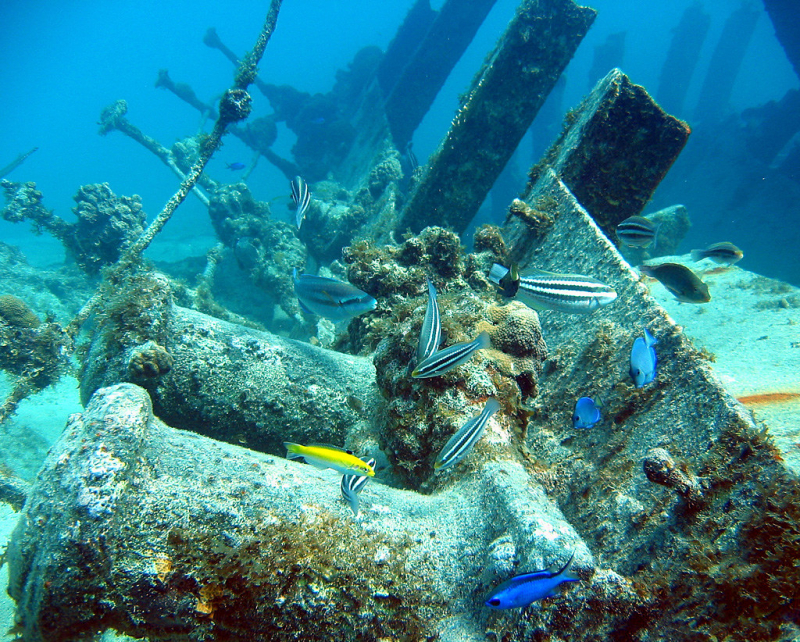
pinterest.com 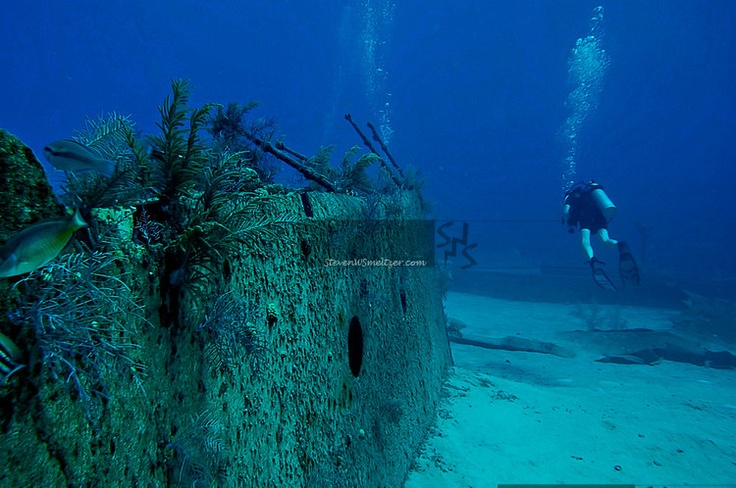
pinterest.com -
The wreck of the MV Captain Keith Tibbetts is located on the northwest side of the Brac, and is also accessible by boat from Little Cayman. This 330-foot-long Koni II class frigate was built for the Cuban Navy in 1984 by the Soviet Union. In 1996, the Cayman Islands government bought it for tourism and scuttled it off the coast of Brac. The MV Captain Keith Tibbets was renamed after a local dive operator. nIn 2004, Hurricane Ivan wreaked havoc on the land and tore the Tibbetts in half, scattering a lot of debris. The wreckage appears to have met a dramatic end, rather than a planned scuttling, due to old wiring and parts dispersed by the hurricane.
The turret guns remain in place and provide excellent photographic opportunities. Instead of penetrating the wreck, you should concentrate on the outside. For experienced wreck divers, there are several safe entry points, but proceed with caution and don't attempt penetration without the proper equipment and experience. Although the wreck has only been underwater for 20 years, the sea life has established itself. Just off the bow, you can see coral growth on the reef wall, and there's a friendly resident goliath grouper. The months of March and April are the busiest for visitors. It can get quite wet between May and November. Water temperatures range from 76 to 82 F (24 to 27 C) all year. For most divers, a 3mm to 5mm wetsuit should suffice.
Location: northwest side of Cayman Brac, Cayman Islands
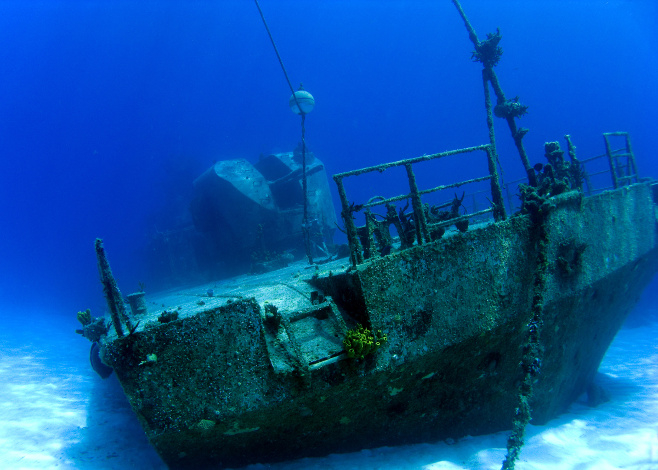
scubadiverlife.com 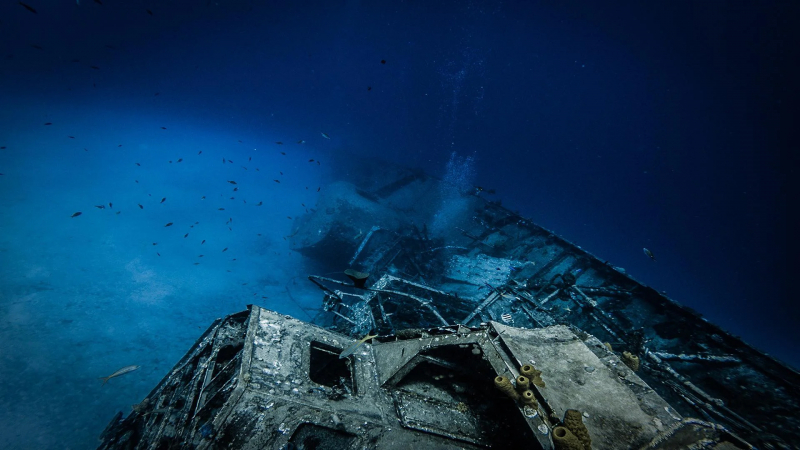
reddit.com -
A popular spot for snorkelers and scuba divers in the reef-rich, near-shore waters of Grand Cayman is Cheeseburger Reef, which got its name not from anything under the sea, but rather for its proximity to a topside fast food restaurant. A pair of orange mooring buoys mark the start of the coral reef, which is about 20 yards off the shore.
Stingrays and reef fish can be seen from the sandy seafloor, about 40 feet down, while exploring Cheeseburger Reef's numerous tunnels and reef formations. With coral heads within 10 feet of the surface, snorkelers will have plenty to see. Divers and snorkelers should also visit the shipwreck Cali, a freighter that sank in just 20 feet of water near the reef. Butterflyfish, triggerfish, shrimp, snapper, and other fish species can be found in and around the large coral heads that sit just beneath the water's surface. A nurse shark will occasionally rest on the sand. The colors in this shallow dive site pop, making it a good choice for photographers.
Location: George Town, Grand Cayman, Cayman Islands
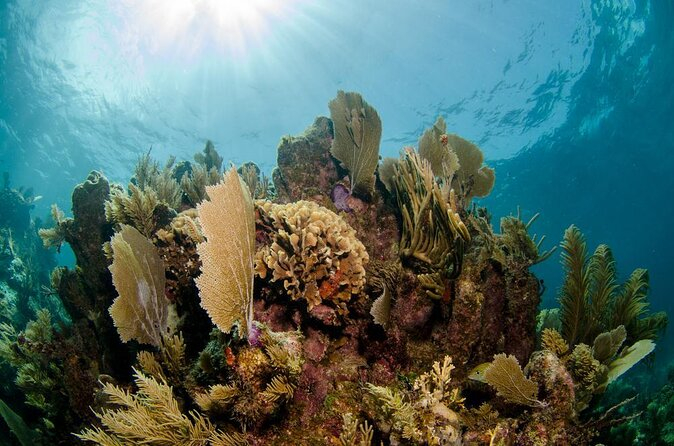
viator.com 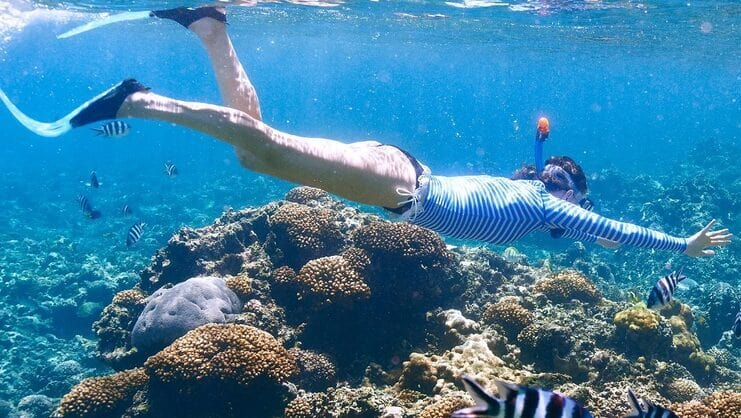
thingstodocayman.net -
Ghost Mountain, located near Grand Cayman's north point, is likely named after the massive mushroom-like pinnacle that appears out of nowhere as divers approach it. While the visibility here is often a little clouded, that’s thanks to the nutrient-rich flow of water which enriches the corals on the pinnacle. The top of the "mountain" is 15m/50ft, but the bottom is around 90m/200ft, so divers should keep an eye on their depth gauges as they circle the "mountain."
Ghost Mountain is home to a swarm of schooling reef fish, and the pinnacle is carpeted in deep, bloody-red finger sponges. The banded coral shrimp are a must-see for macro photographers, and divers with a depth limit of 30m/98ft will enjoy the gorgonian sea fans in the cavern at this depth. Around the reef, you can expect to see thriving gorgonian fans and octopus sponges. This is a hotspot for groupers and wrasses along the reef.
Location: on the north wall in West Bay, Cayman Islands
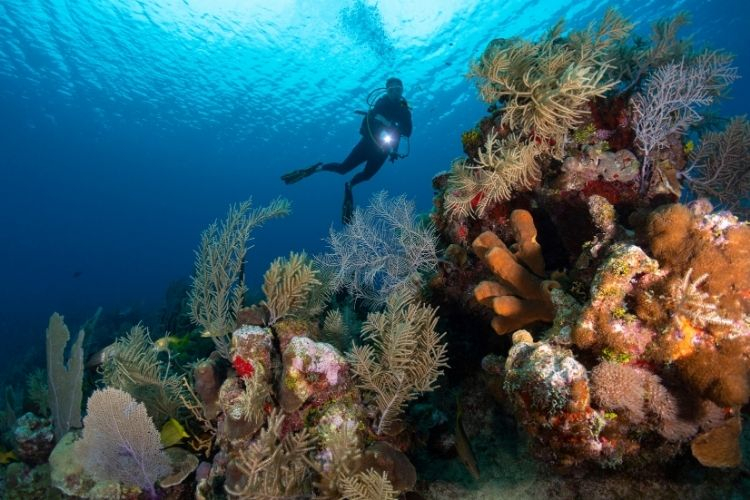
tufidive.com 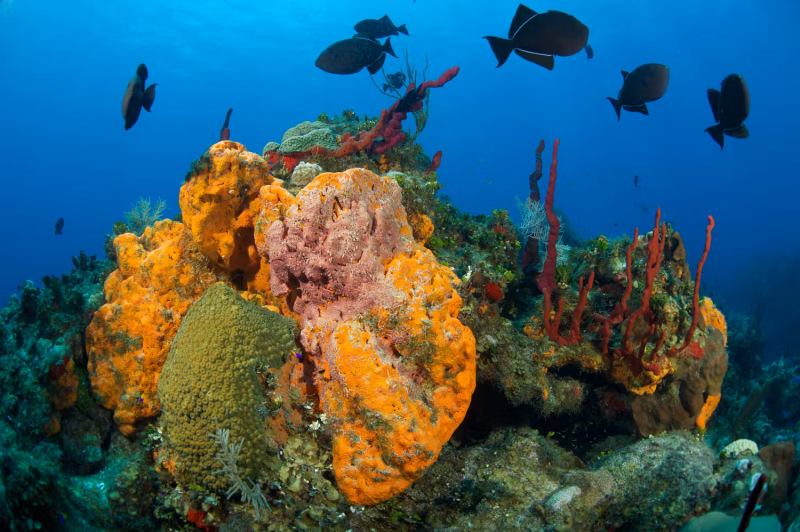
flyandsea.com -
On the west side of the Cayman Islands, Orange Canyon is one of the more well-known and popular scuba diving spots. Orange Canyon is a dive site recommended for advanced divers and is located on the northwest tip of Grand Cayman's west side. The dive progresses along the wall, where you can look out into the blue for large pelagic species like sharks and Spotted Eagle Rays, before finishing at the top of the wall, where you can explore various corals, sponges, fish, eels, and turtles.
As the name implies, Orange Canyon features a deep canyon surrounded by impressive orange sponges, which makes for a great photo backdrop. Divers can swim along the wall and spot eagle rays, schools of tarpon, silversides and Horse-eyed Jacks to name just a few. In addition, various colorful corals and sponges can be found at the top of the wall.
Location: On the northwest tip of the west side of Grand Cayman, Cayman Islands
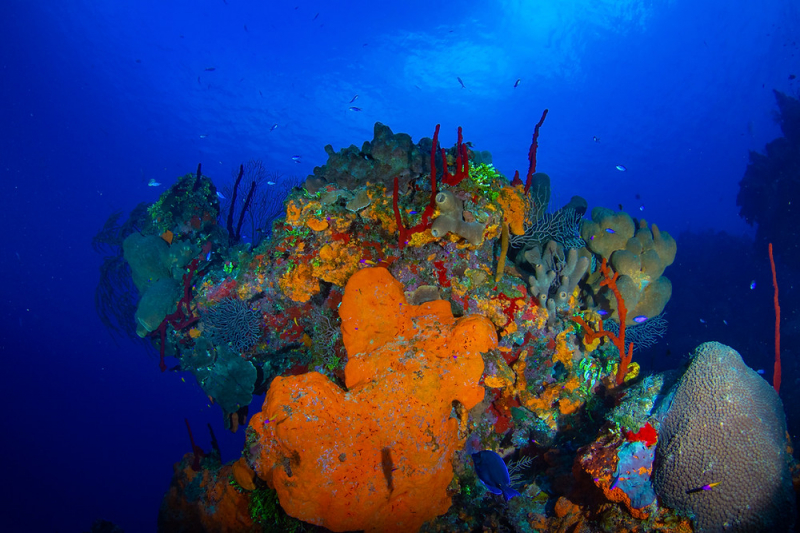
indigodivers.com 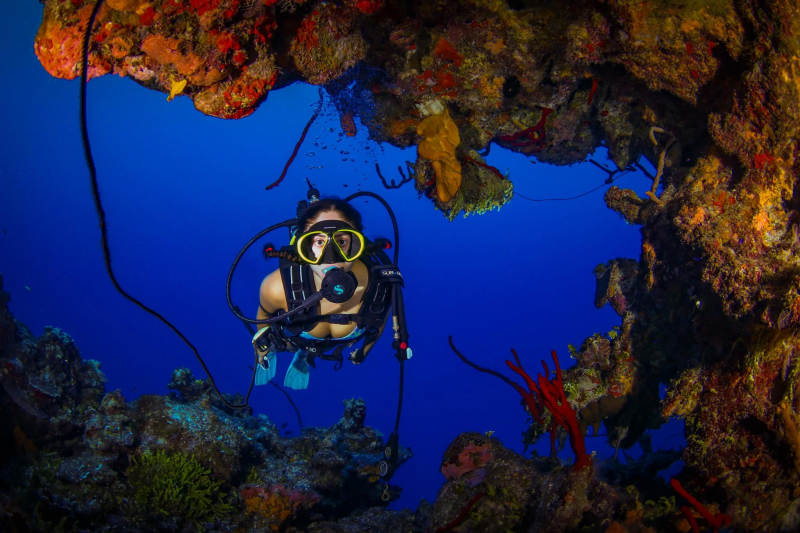
reddit.com













